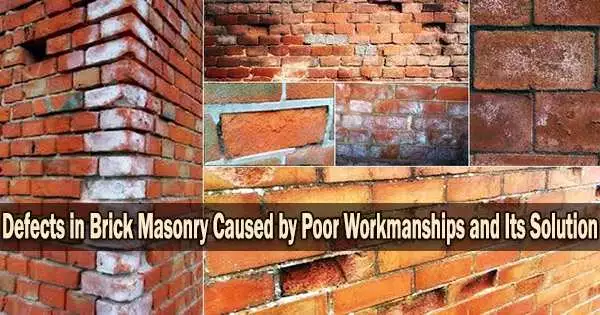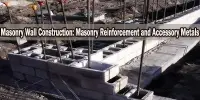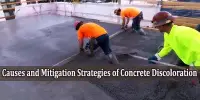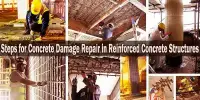Poor masonry work supervision leads to workmanship defects in brick masonry. The causes of various brick masonry flaws and how to fix them are covered. Construction of brick masonry works is typically carried out by masons without sufficient supervision, unlike construction of reinforced concrete structures. Any structural member that is constructed without sufficient oversight always has questionable and unknown strength and longevity.
If brick masonry structures underwent the same level of inspection as concrete ones, their quality would be just as reliable. Therefore, it is essential that designers and construction engineers understand the craftsmanship variables that are important in creating designated strength. This is demonstrated by performing tests on walls that have known flaws added to them and contrasting them with testing on sound walls.
Practically speaking, these flaws in brick masonry are inevitable and do exist to some degree, but their combination and poor construction lead to a reduction in masonry strength of up to 50%. Brick masonry building must be correctly constructed and managed to keep the flaws brought on by poor workmanship to a minimum.
Following are the poor workmanship which results in the defects of brick masonry construction:
- Failure to fill bed joints
- Bed joints of excessive thickness
- Deviation from verticality or alignment
- Exposure to adverse weather after laying bricks
- Failure to adjust suction of bricks
- Incorrect mixing and proportioning of mortar
Defects in Brick Masonry due to Failure to Fill Bed Joints
The proper filling of bed joints in brick construction is extremely important. Inadequate bed joint filling or mortar gaps may result from moving too quickly, not paying enough attention, or from a process known as furrowing.
By “furrowing,” a mason implies making a gap in the mortar bed in the middle, parallel to the face of the masonry wall. Test results show that insufficient bed joint filling might reduce masonry strength by roughly 33 percent. It has been demonstrated that the flexural strength of a masonry wall will suffer more damage from failure to fill vertical joints than the compressive strength of the masonry.
Inadequate vertical joint filling compromises the building’s ability to resist water infiltration as well as sound insulation, and it essentially shows the bricklayer’s carelessness.
Defects in Brick Masonry due to Excessive Thickness of Bed Joints
It is alleged that increasing the thickness of brickwork bed joints causes masonry compressive strength to decrease. This is due to the fact that thicker bed joints result in greater lateral tensile stresses in brick masonry than narrow bed joints do. Finally, a bed joint with a thickness of 16 to 19 mm will have a maximum 30% reduction in compressive strength compared to a bed joint with a thickness of 10 mm.
Defects in Brick Masonry due to Deviation from Verticality or Alignment
Brickwork in masonry that is built out of plumb or out of line with walls on lower or higher stories will result in an increase in eccentric loads, which will weaken the brickwork. It has been determined that a wall that is bent or out of alignment by 12–20 mm will be roughly 13–15% weaker than similar walls without such a problem.
Defects in Brick Masonry due to Effects of Weather
It is strongly advised to keep freshly built bricks away from intense heat or freezing temperatures until the mortar has sufficiently hardened and grown strong. When brick walls are exposed to hot weather, they may lose a lot of moisture, which can prevent cement from fully hydrating and prevent mortar from reaching its typical strength. It’s possible that moisture loss causes brickwork to lose roughly 10% of its strength.
Freezing can result in the vertical displacement of masonry walls and a corresponding loss of strength. Using the right tools, the issue brought on by hot and freezing weather might be solved. For example, heating building materials may be a smart technique while laying bricks in freezing weather. Polythene sheet can be used to cover brickwork in hot temperatures to cure it effectively.
Failure to modify the bricks’ suction Small but substantial issues could develop when slim walls must be built with highly absorbent bricks. The slight side to side movement of the brick will cause the mortar to transform from flat to pillow-shaped.
Brick suction causes mortar to lose water, which may prevent the mortar from resuming its flat shape. Due to the mortar bed bending or swelling out of form, this results in an unstable wall that may lose half of the strength that was predicted when the ratio of bricks to mortar was given. Brick suction can be reduced to less than 2 Kg/m2/min by wetting them before laying them, which will solve the issue. Finally, adding some lime to the mortar mixture will be advantageous because it prevents brick suction and subsequently keeps the water in the mixture from evaporating.
Defects in Brick Masonry due to Incorrect Mixing and Proportioning of Mortar
It can be observed from the figure that, for crushing brick strength of 50N/mm2, decreasing mortar strength from 11N/mm2 to 4.5N/mm2 it is anticipated that brickwork strength decrease from 14N/mm2 to 11N/mm2. And this is equal to reduction of about thirty percent cement in the mortar or changing mortar mix from 1:3 cement: sand to 1:4.5.
The high water to cement ratio that is utilized to create a workable mortar mix can also be used to determine mortar strength. As a result, it is crucial to rigorously adhere to the mortar proportioning or other standards.
However, there are tiny tolerances that offer enough leeway to account for tiny mistakes made in the mortar’s proportioning and mixing. Use of excessive or substantial amounts of plasticizer in place of lime will result in the creation of a porous and most likely weak mortar. To preserve and protect the mortar in this circumstance, it is vital to take the appropriate action.
















